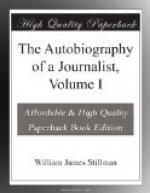The personal relations between Rousseau and Millet were in the best sense of the word fraternal, and from neither did I ever hear a word to the disparagement of a brother artist, while Rousseau used to talk in the subtlest vein of critical appreciation of his rivals among the landscape painters, the Dupres, Ziem, Troyon, and others, so that I regret that in those days I thought only of my own instruction, and not of the putting on record the opinions of a man whose ideas of art were amongst the most exalted I have known.
A charming nature was that of Troyon, a simple, robust worker, and, like all the larger characters in the French art world with whom I became acquainted, full of sympathy and guidance for those who wanted light and leading. But the lives of these three great painters, like that of Corot (whom I never knew personally), show how completely the French public, so proud of its intelligence of art, ignored the best qualities of it till outsiders pointed to them. Troyon told me that for the first ten years of his career he had never sold a picture, but lived by painting for Sevres; the prosperity of Millet came from the patronage of American collectors, led by the appreciation of a Bostonian painter, William Hunt, and I well remember his famous “Sowers” on the highest line in the Salon, so completely skied that only one who looked for a Millet was likely to see it; while Rousseau, at the time I speak of, was glad to accept the smallest commission, and sold mostly to American collectors. Nor is it otherwise with the Rousseaus, Millets, and Troyons of to-day—the public taste, and the banal criticism of a journalism at its best the tardy echo of the opinions of the rare wise man, find genius only when it has ceased to have the quality of the new and unforeseen.
Yvon, in whose atelier I worked, was essentially a teacher, and his more recent assignment to the directorship of the Ecole des Beaux-Arts put him in his true place, that of a master of style in drawing and the elements of art instruction. He was engaged, when I knew him, on the battle-pieces of the Crimean war, the chief of which were already at Versailles. His was an earnest, indefatigable nature. He was as kindly and zealous a teacher as if he were receiving, like his English confreres, a guinea a lesson. Nothing so strongly marked the difference between the French and the English feeling for art as this characteristic feature of the disinterestedness of the French artist in giving instruction without compensation, while his English colleague of equal distinction gave instruction only at a price impracticable for a poor artist, if indeed he would give it at any price. And even thus, the English drawing-master did not teach art, but facile tricks of the brush. Need one seek any other reason for the curious fact that, with a marked superiority in the occasional highest attainment of rare and original abilities which English art shows, France has become the school of Europe, than that in




